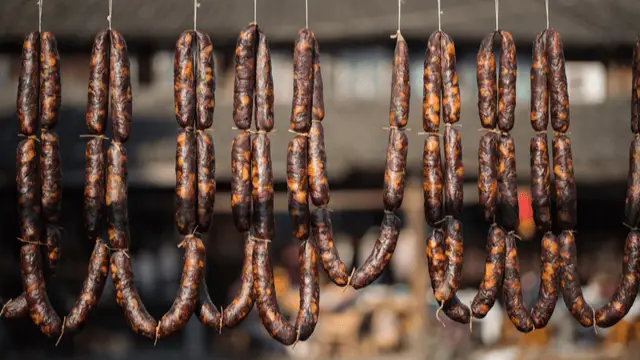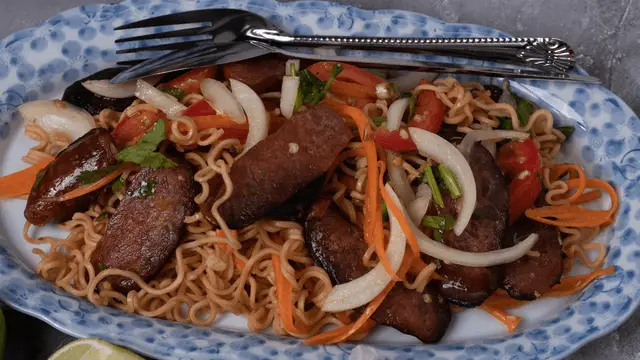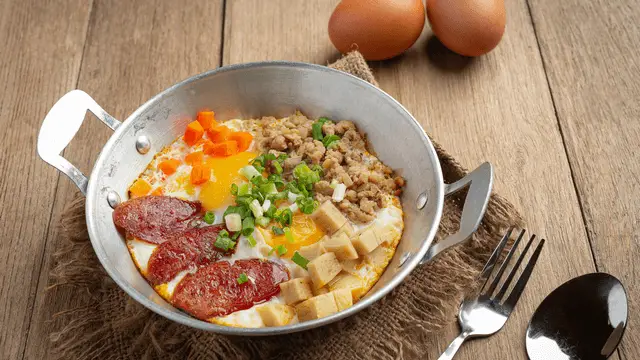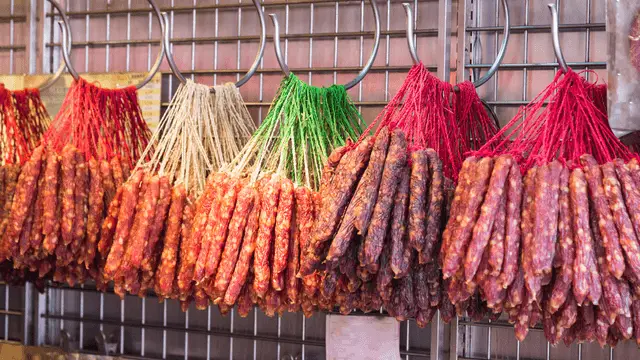What do you think of when you hear the word ‘sausage’? Long links of pork, beef, and veal flavored with salt, pepper, garlic, and other herbs? Kielbasas, bratwurst, and andouille? While these are some of the most common European sausages, Chinese have also made sausages for centuries. But how do the Chinese variety compare to European sausages in terms of carb content?
Although no two brands are exactly the same, most Chinese sausages contain added sugars and flavorings that may make them unsuitable for a keto diet. That being said, if you consume them in small quantities, they are safe for your diet. Additionally, there are a handful of brands that make keto-friendly Chinese sausages.
In this article, we’ll take a closer look at the main differences between European and Chinese sausages. We’ll also explore whether Chinese sausages are suitable for a keto diet. Lastly, we’ll cover how you can incorporate them into your meal plans without ruining your diet.
What are Chinese Sausages?

Although most Westerners think of Europe when they consume sausages, the Chinese have been making sausages since as early as the Qin Dynasty (221-206 BC). Like the European varieties, Chinese sausages, or lap cheong, are usually made from pork and spices, and then smoked or grilled over a fire. However, lap cheong sausages are unique in that they’re often made with rice rather than breadcrumbs.
By adding steamed rice to the meat mixture, Chinese sausage makers are able to make a sticky mixture that easily holds together in a casing. Some other differences include the spices used to flavor lap cheong sausages. While European sausages are usually flavored with garlic, onion, or black pepper, Chinese sausages are often flavored with five-spice powder and Sichuan pepper.
Yet the biggest difference between the two is the amount of sugar used to make lap cheong sausages. When you eat a Chinese sausage, you’ll notice that it’s sweeter than a standard European or North American sausage. This is perfect for anyone who likes the pairing of salty and sweet flavors. However, it’s not necessarily great for your keto diet.
How Do You Cook & Serve Chinese Sausages?

Recipes using Chinese sausage vary greatly from region to region. China is a massive country with a wide variety of cuisines. Therefore, it’s hard to pinpoint one exact dish that uses the ingredient. However, you can eat them cooked or uncooked, since you would steam, grill, or smoke them during the manufacturing processes.
There are many ways to serve lap cheong. You can fry them with vegetables, add them to soup, or use them as a flavor additive. Lap cheong is especially popular in Cantonese cooking, where it’s often used as an additive in fried rice.
How Many Carbs are in Lap Cheong Sausages?

It’s hard to give an exact answer, since no two brands use the same recipe. Most lap cheong sausages contain around 5 grams of carbohydrates in each link. This is in addition to 9 grams of protein, 21 grams of fat, and 650 milligrams of sodium. To put those numbers into perspective, carbohydrates make up roughly 15% of the total net weight for a single link.
Most of these carbs come from added sugars and rice used to sweeten the sausages. But at these ratios, are Chinese lap cheong sausages keto-friendly? Considering that the idea behind the keto diet is to consume a high-fat, low-carbohydrate diet, it’s hard to class this ingredient as entirely keto-friendly.
Comparing the ingredients, fats make up most of the calories. Carbohydrates make up 4x less of the calories than fat does. However, compared to other sausages, lap cheong sausages are far less keto-friendly. For example, if we take a look at Johnsonville Original Bratwursts, we find only 2 grams of carbohydrates, meaning that Chinese sausages contain 2.5x more sugar.
In short, while lap cheong sausages fit the mold of high-fat, low-carb keto ingredients, they’re not the most keto-friendly. Nonetheless, if you’re making Chinese food and want to add extra flavor, there’s nothing wrong with adding a couple. Just be sparing and avoid added sugars elsewhere.
Making Your Own Lap Cheong Sausages

If you enjoy eating Chinese sausages but don’t want to consume more sugar than your diet will allow, you can make your own. If you have the time, patience, and cooking experience, preparing your own batch can be as easy as combing ingredients and stuffing them into sausage casings.
Of course, you’ll need access to a quality Asian grocer. While there, pick up 10 lbs. of moderately lean pork, red rice yeast, a Chinese wine such as Shaoxing or baijiu, and some Sichuan peppercorns. You should be able to find the rest of the necessary ingredients at your local supermarket.
The benefit of making your own sausages is that you can control the amount of sugar in the recipe. We don’t recommend using too much rice, as it can make your sausages hard and crumbly. But feel free to eliminate the sugar entirely if you want. Additionally, be careful to not add too much rice wine, as alcohol metabolizes directly into sugar.
For a quality recipe and guide to making your own lap cheong sausages, view our recipe here. It has enough details for anyone to follow and you can complete it in a reasonable amount of time.
Conclusion
Chinese lap cheong sausages might not be the first thing you think of when you consider sausages, but they’re just as old and cherished as any other European variety. However, they are far sweeter than European sausages, thanks to added sugar, wine, and rice. This makes them less keto-friendly than other types of sausage but they still fall within the range of keto-friendly ingredients.



Leave A Comment